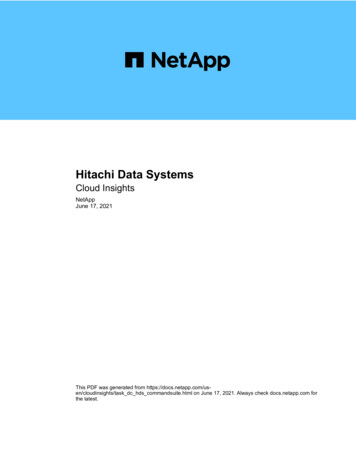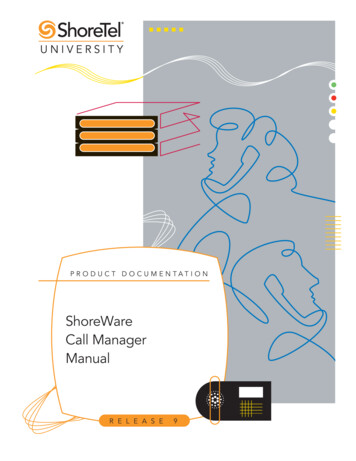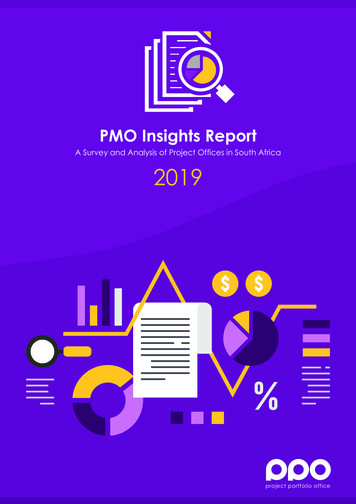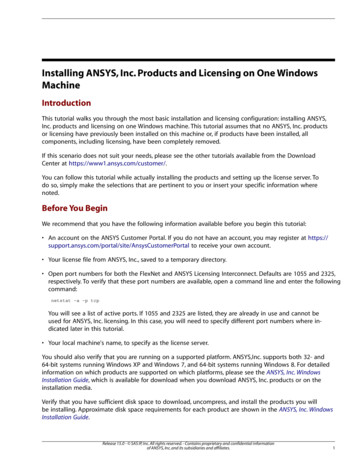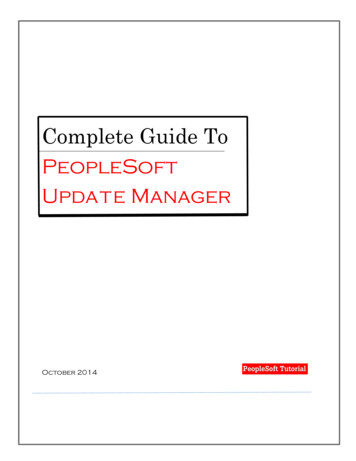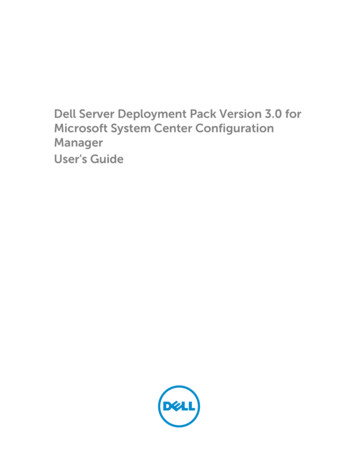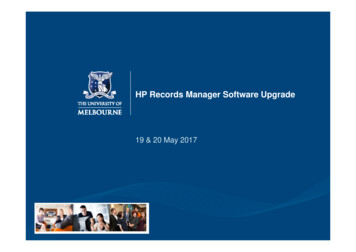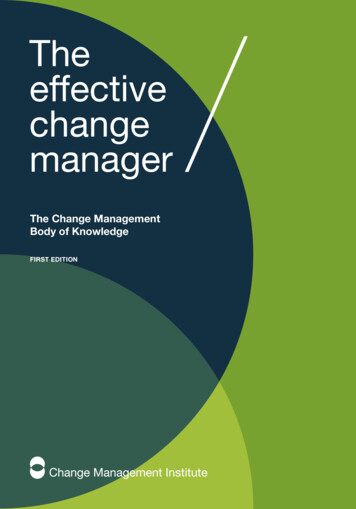
Transcription
TheeffectivechangemanagerThe Change ManagementBody of KnowledgeFirst edition/
TheeffectivechangemanagerThe Change ManagementBody of KnowledgeFirst edition/
ISBN 978-0-9923624-0-9First edition 2013 Change Management InstituteThe mission of the Change Management Institute (CMI) is to promote excellence inthe management of change by setting standards, educating and supporting changemanagement practitioners and organizations and promoting the value of changemanagement.We are an independent professional organization that is uniquely positioned toadvance the interests of change management. Since 2005, CMI has been providingopportunities for change management professionals to build knowledge and skills andnetwork with other professionals.We provide: Education – developing the capability of change practitionersNetworking – hosting a range of networking opportunitiesAccreditation – developing standards and recognizing excellence in themanagement of changeAs a member-owned organization we focus on delivering real benefits to our membersand offer: Credibility – membership and affiliation to a professional industry organizationCapability – access to professional development opportunitiesConnection – local connection within a global communityDiscounts – special member prices on events and benefitsOur organization is built upon the support and effort of our incredible volunteers. Wetruly are members supporting members and offer a strong peer network of changeprofessionals. We hope that you will become part of CMI and support the evolution ofthe change management industry together with us.www.change-management-institute.com
ForewordI am delighted to introduce you to the first official and independent ChangeManagement Body of Knowledge for the Change Management profession.Our members and stakeholders told us the time had come to define theknowledge that our profession relies on. Newcomers to Change Managementtold us they needed a reliable and independent single source of truth toguide their professional development. To experienced practitioners this feelslike a ‘coming of age’ for Change Management.The feedback we have had on this first edition is encouraging. There werecomments, such as:‘[The CMBok] strikes a good balance between being ‘professional, theoreticaland credible’ with being ‘accessible, understandable and practical’ forpracticing or aspiring professionals‘’I thoroughly enjoyed reading this content. It is well written, gave me sometimely reminders about the varied aspects of an effective Change Manager’swork and inspired me to seek out some new readings.’‘Very, very impressive!‘Now we want to hear from you. As with all our standards, this one has beencarefully developed and tested over a long period involving a wide range ofstakeholders. We know our profession is still growing so it is constantly openfor feedback and we’d love to hear what you think. Tell us if we’ve missedsomething or if you have a great book or article that you refer to frequentlyso we can share this information with your colleagues across the professionand across the world.Finally I would like to add a personal thank you to the team involved inwriting, managing and reviewing this incredible resource. Creating it hasbeen a three-year journey for CMI and it would not be in your hands nowwithout the hard work (most of it unpaid) of a group of dedicated people.Now turn the page and enjoy! I guarantee you’ll learn something. I did.Caroline PerkinsPresident, Change Management InstituteThe Effective Change Manager 1
2 The Change Management Institute
IntroductionChange Management has its roots in the second half of the 20th Century.Changes in social and organizational structures, frequently driven bychanging technology, created an environment of rapid and discontinuouschange. Business leaders, managers and professionals from a range ofdisciplines recognised the challenge of creating and sustaining value inthis challenging environment. It became a commonplace observation thatchange in organizations frequently became chaotic; it destroyed value,rather than creating it.ChangeManagementis an emergingprofessionOrganization Development practitioners and academics approached changefrom the perspective of psychological and social disciplines. Half a centuryof social science research was plundered to gather insights that might helporganizations to engage people more effectively in the change process.The human side of change became a key driver of success.Project and Programme Management professionals, drawing on operationalresearch and other well-developed academic disciplines approached changefrom a different perspective. Their fast-developing profession providedpowerful tools to define, plan and control change initiatives in organizations.They offered structures and processes that reassured organizations thatchange could be managed.Systems theory, chaos theory and other powerful strands of thoughtalso made their contributions to understanding change and shaping theway it is managed. Large consulting firms began assigning their mostcapable practitioners to support organizations approaching significantchanges. The literature of Change Management became more and moreprominent in business and universities began to offer courses dedicated toChange Management.From these diverse professional backgrounds, a number of individualsbegan to define themselves as Change Specialists or Change Managers.Organizations, struggling to maintain or increase value through times ofchange started to employ people in roles identified as ‘Change Manager’,either internally or through external recruitment processes. Consultantsadvertised their Change Management services and were engaged to provideguidance. The discipline of Change Management began to form.The Effective Change Manager 3
ChangeManagementis aninterdisciplinaryprofessionThere is a substantial and growing body of literature about organizationalchange. However, it is clear that effective Change Management draws onthe expertise of a wide range of other professional disciplines. The historyof Change Management illustrates some of the disciplines that contributeto the effective management of organizational change. In this ChangeManagement Body of Knowledge (CMBoK) we have sought to identify,recognize and calibrate those elements on which the Change Managementprofession relies.The specific context of any change initiative or process will determine whichof these elements are most significant. That context includes the national,ethnic and organizational cultures in which the change takes place. It alsoincludes the particular nature of the change and the forces that are driving– and resisting – it. It certainly includes the people involved, especially thoseleading the change process, and the outcomes that are required.Because of this variation in the context, no single definition of the knowledgerequired to underpin effective Change Management will meet with universalapproval. Professionals with different orientations, from different cultures andfacing different challenges will (unsurprisingly) reach different conclusionsabout the ‘correct’ content of a CMBoK.In this edition we have built on eight years of Change Management Instituteresearch which has defined what effective Change Managers actuallydo. This research has drawn on the experience of more than six hundredChange Management professionals in thirty countries, and is published asa competence framework for a Change Management practitioner (www.change-management-institute.com).In developing this CMBoK we have engaged in further research with asimilarly global constituency to define and balance ideas about what ChangeManagers must know in order to display those competences effectively –and to deliver change successfully. Our decisions about what to include, andwith what emphasis, will not please everyone – but the results are based onstrong global foundations. We believe it to be a worthwhile contribution todefining this emergent profession.4 The Change Management Institute
The Change Management profession is no longer embryonic and is readilyidentifiable in organizational, and especially in business literature. Nor isChange Management in its infancy. Early faltering footsteps and hesitantspeech have given way to a sense of balance about the profession and toa clear voice that articulates a strong contribution to thought leadership.Perhaps, however, we could say that Change Management is in itsadolescence. It is no longer dependent on its parent disciplines – such asorganization development and project management – and is becoming‘its own person’. Parental influences are still strong, but it is now makingsubstantial and distinctive contributions to the world around.ChangeManagementis an developingprofessionHowever, the Change Management profession is itself in a state of rapidchange and growth. Our research shows that the numbers of explicitlyChange Management jobs is growing, and more organizations are activelyseeking to build Change Management capacity and capability. The shapesof these initiatives are many and varied; the knowledge and competenceof the effective Change Manager still needs to evolve to meet the resultingdemands. New ideas and innovative approaches –spread by online forumsfaster than printed literature can keep up – are rushing around the globe andare driving behaviour which varies from thoughtful and highly sophisticatedto reflexive and faddish.This is a good time to identify the best in the developing Change Managementprofession. We have taken an ‘agile’ approach in the CMBoK. We have chosennot to wait until all is clear and the evidence is universally agreed. This firstedition is a work in progress. As we publish we are already gathering dataand insights from the global Change Management community, which willshape the second edition. Through this iterative process we aim to maintaina clear, current, convenient and valuable reference to what organizationsrequire of an effective Change Manager.The Effective Change Manager 5
What is a ‘Body of Knowledge’?ChangeManagementknowledgethat underpinseffective practiceA ‘Body of Knowledge’ is a document produced by a professional associationto describe and define the knowledge that underpins effective practice in atrade or profession.The CMBoK: Identifies the Knowledge Areas required to practise effectively as aChange Manager across a range of situations; Provides definitions and descriptions of each of these Knowledge Areas,including a clear indication of the depth of knowledge required in each area; Shows how areas of knowledge relate to one another, and to theirpractical application in the Change Management Institute competencemodel; and Offers a reliable, reputable and realistic range of reference sources inwhich these Knowledge Areas can be found and studied.PurposeA Body ofKnowledgefor ChangeManagementthat provids afirm foundationfor organizations,practitioners,authors andacademicsThis CMBoK is designed for practitioners, employers, authors and academics.It provides:1. Practising Change Managers – or those aspiring to practise as ChangeManagers – with a recognized outline of the required knowledge (forthose seeking accreditation through the Change Management Institute’sprofessional accreditation scheme it describes the knowledge applicantsmust display in their work);2. People employing Change Managers (or contracting for ChangeManagement services) with a description of the areas of expertise theycan reasonably expect of an applicant; and3. Authors and academics with well-researched information on which tobase books and courses.6 The Change Management Institute
The CMI Change Management Maturity Model and the CMBoKThe CMI Organisational Change Maturity Model outlines three levels ofmaturity in our discipline:1. Project change management2. Business change readiness, and3. Organizational change leadership.The table at Appendix A (see page 186) summarises how this guide relates toall three maturity levels.The CMBoKsupports theproject levelof the CMIOrganisationalChangeManagementMaturity ModelIn response to feedback from members we have focused this first editionof the CMBoK on project change management and the role of the ChangeManager as outlined in our Change Management Practitioner CompetencyModel. Where it is relevant we have made reference to concepts from theorganizational and business domains (such as Change Management Offices,emergent change and change leadership) but not covered them in detail.As the body of knowledge develops we expect to incorporate the feedbackwe receive to expand on the specific knowledge underpinning practice inthe business and across the organization.The CMI CMBoK in contextPractitioners from across the world have developed CMI’s independentChange Management standards and these have been in use for several years.They include two models:1. The Change Management Practitioner Competency Model (issued in2008, updated in 2010 and 2012) defines what a practitioner does; and2. The Organizational Change Management Maturity Model (issued in 2012)outlines what a mature organization does.The CMBoKcomplementsthe PractitionerCompetencyModel and theOrganisationalMaturity ModelInformation about both models can be downloaded ools-modelsThe CMBoK describes the knowledge that underpins Change Managementpractice across both domains.The Effective Change Manager 7
Practitioner accreditationCMI offers accreditation of Change Management practitioners againsta well-established global benchmark. Accreditation provides colleaguesand employers with an independent validation of a practitioner’s ability toperform a Change Management role effectively. The accreditation schemewas developed in response to an ongoing call from practitioners for a highquality, robust and reliable assessment process to recognize excellence in themanagement of change. Those that have been awarded their accreditationtell us it creates a greater respect for them and the profession and it helpsthem to stand out from the crowd when applying for new roles. Employerstell us how relieved they are to have an independent assessment of acandidate’s workplace performance to rely on.Practitioners with typically three or more years’ experience aim for the ACM(Accredited Change Manager). The benchmark standard used is the CMIChange Management Practitioner Competency Model. The assessmentprocess involves both a written and face to face assessment, as well asreference checks.Less experienced practitioners (typically with one to three years’ experience)aim for our foundation level accreditation. They provide evidence of ChangeManagement knowledge (based on this CMBoK) as well as examples of theirexperience in a novice level Change Management role.Go to the CMI website to find more about accreditation.8 The Change Management Institute
This is just the beginningOur profession is built on a foundation of consultation and this has beendemonstrated in the way the CMBoK has been developed. The contentreflects the views of CMI members and stakeholders over a three year periodfrom 2010 to 2013.Our profession is constantly developing and this is reflected in the way wemanage this body of knowledge. We see it as a constant ‘work in progress’always being updated with feedback from our community. In line withthis, and the approach we take with all our standards, the CMBoK is alwaysopen for feedback and will be updated regularly. As this is the first issue weanticipate an update towards the end of 2014, then another every two yearsafter that. Keep an eye on the CMI website for deadlines!The CMBoKreflects adevelopingprofession and isa constant ‘workin progress’ thatwill be updatedregularlyYou can provide input at any time and there are two ways to do this:1. Complete the short 10 minute survey on the CMI website (available ok); and2. Send us an email at cmbok@change-management-institute.com. Pleaseprovide the relevant page and section references so that we can usethe feedback you provide. If you would like to see specific literaturereferences included please provide full details following the format usedin this document.The Effective Change Manager 9
AcknowledgementsThe CMBoK isa collaborationbetween CMIand the APMGand is a productof the effort,enthusiasm anddedication of ateam of expertleads, authorsand reviewersCMI would like to thank APMG International for the partnership and supportdemonstrated throughout this project. Given CMI’s independent statusthe decision to partner with another organization was not taken lightlyand involved several months of negotiation. We have been delightedwith the cooperation and collaboration demonstrated between the twoorganizations throughout.BelieversThe global Change Management community would like to recognize thevision, energy and determination of the leaders of both organizations intaking this from a good idea to a valuable contribution to the global practiceof Change Management.Caroline Perkins (CMI), Richard Pharro & Keith Williams (APMG)AuthorsCMI would like to recognize the authors of the document who workedtirelessly to turn everyone’s contributions and suggestions into a valuablecoherent reference.Dan Skelsey, David King, Ranjit Sidhu, Richard SmithThe authoring team appreciates the consistent support of their work givenby Gavin Webb (APMG).CMBoK LeadsCMI would like to recognize the contribution of the CMBoK Leads who setthe tone for the collaborative development and delivered a quality productto a seemingly impossible deadline.Helen Campbell (CMI), Richard Smith (APMG)10 The Change Management Institute
Review panelCMI knew that Change Managers were keen to get their hands on this firstedition, so we used the data from three years of consultation to developan initial draft. Then we asked all those responding to the CMBoK survey“Who would you trust to review the first draft of the CMBoK on your behalf?”The responses drove the composition of the review panel with reviewerscoming from the UK, the USA, from Europe, Australasia and China. The panelincluded academics, practitioners and Change Management experts as wellas CMI Board members, CMI Country Leads and CMI Accredited ChangeManagers (ACMs).This CMBoK, like every other CMI initiative, is the product of many hours ofhard work given freely by volunteers. While this document is the product ofmany people’s input CMI particularly recognizes the significant contribution,and many hours of work invested in the review, by the following people:Arnab BanerjeeDr Elizabeth ShortDr Janet ColeBithika O’DwyerDavid MillerJo MillottCaroline Perkins ACMEmma Hansford ACMMelanie Franklin ACMChantal PatrunoFran Leys ACMNicola BusbyChris Bayley ACMGillian Perry ACMPatrick MayfieldChris MacdonaldHelen Campbell ACMPhil AngellDr Christina KirschIra Blake ACMTanja van den AkkerClare EllisJane JuddThe Effective Change Manager 11
Editorial and practical informationabout the CMBoKOrganization of the CMBoK‘KnowledgeAreas’ and‘KnowledgeComponents’For the purposes of the CMBoK, ‘knowledge’ relating to effective ChangeManagement is organized into thirteen Knowledge Areas. Each KnowledgeArea describes a major aspect of the underpinning knowledge and practicalexperience expected of an effective Change Manager.Within each Knowledge Area there are three or more Knowledge Components– distinct but related subsets of the Knowledge Area under which theyare described.Tools and templatesWhere tofind help withpractical toolsand templatesTools and templates are an important resource for Change Managers; theirknowledge helps them to decide which specific tools or templates to usewhen. The Change Management Institute is an independent professionalbody and therefore does not endorse any specific toolsets or methodologies.However, in support of our members we have collected a number of generictools, templates and models, which are available on our website at: ommon terms used in the CMBoKOrganizationsdescribe theirchange plans indifferent waysOrganizations use a wide variety of terms when describing the plansassociated with change processes. This is influenced by their approach toproject, programme and portfolio management. For consistency we haveadopted the following terminology throughout the CMBoK:Change initiative: except where the context requires an alternative, we haveused this term as a general expression to include any intentional changeprocess, including those constituted formally as a change portfolio, changeprogramme or change project.Change management plan: we have used this term for a plan that typicallyincludes change impact, the organization’s change readiness, capabilityand capacity for change, meeting key learning needs and achievementof outcomes.Benefits realization plan: we have used this term for a plan that typicallyidentifies the benefit owners, includes a summary of the benefits of a changeinitiative, states the timing of their expected realization and schedulesbenefit reviews.12 The Change Management Institute
Delivery plan: our use of this term applies to a plan that can be createdat various levels of a change initiative (programme or project) and typicallyincludes the timing and sequence of key implementation tasks, delivery ofoutputs and transition to the business.General referencesThe references used throughout this edition are those that practitioners haveoften cited as being of significant value. A number of these cover several ofthe areas of knowledge in the CMBoK and are listed below for ease of access.Cameron, E. and Green, M., 2012. Making Sense of Change Management: acomplete guide to the models, tools and techniques of organizational change. 3rded. London: Kogan Page.Huczynski, A.A. and Buchanan, D.A., 2007. Organizational Behaviour. 6th ed.Harlow: Pearson Education.Kotter, J.P., 2012. Leading Change. 2nd ed. Boston, MA: Harvard BusinessReview Press.Reference should also be made to related CMI publications:CMI, 2012. Organisation Change Management Maturity. [pdf]CMI, 2012. Change Management Practitioner Competencies v.2.2. [pdf]Both are available sEditorial note on spellingsDuring the review process we received strong feedback about our use of‘z’ in spelling words (such as ‘organization’). Several reviewers expressed theopinion that these words should be spelt with ‘s’. Although the ‘s’ spelling oforganization and similar words is common in the UK and Australia, both ‘s’and ‘z’ spellings are acceptable in British English. In fact, the Oxford EnglishDictionary uses the ‘z’ spelling for its own ‘house style’. We have adopted thesame convention.The Effective Change Manager 13
ContentsYou don’t have to read the CMBoK from front to back – all the Knowledge Areas can beread separately. Use the navigation trees throughout the CMBoK to find your way to thetopics of most interest to you1/A Change Management Perspective– the overarching theories behind change 171.11.21.31.41.51.6Why Change Management matters.21Change and the individual.23Change and the organization.26Key roles in organizational change.29Organizational culture and change.32Emergent change.342/ Defining Change – what is the change?. 372.12.22.32.42.5.Aligning change with strategy.39Drivers of change.41Change definition.43Developing vision. 45Scenario design and testing.473/Managing Benefits – ensuring change delivers value. 513.13.23.33.4Benefits management principles and processes. 54Benefits identification, mapping and analysis. 56Planning benefits realization. 58Supporting benefits realization. 604/ Stakeholder Strategy – how to identify and engage stakeholders. 634.1.4.2.4.3.Identifying and segmenting stakeholders.65Stakeholder mapping and strategy.67Managing relationships and mobilizing stakeholders.695/Communication and Engagement– communicating change effectively. 735.15.25.35.4Theory of effective communicating.75Communicating change.77Communications channels.79Planning communications.816/Change Impact – assessing change impact and progress. 856.16.26.3Assessing the impact of change.87Assessing and managing the risks of change.89Business continuity and contingency during change.9114 The Change Management Institute
7/Change Readiness, Planning and Measurement– preparing for change. 957.1.7.2.7.3.7.4.Building individual motivation to change.97Building organizational readiness to change.99Planning for resistance. 102Measuring change effectiveness. 1058/Project Management – change initiatives, projects and programmes. 1098.18.28.38.48.5Change within project governance structures.112Establishing a project.115Change planning and scheduling.117Executing change within a project environment.119Transitioning to the business.1219/ Education and Learning Support – training and supporting change. 1259.19.29.3Learning theory and skills development. 128Identifying and meeting learning needs. 130Behavioural change and coaching.
Change Management standards and these have been in use for several years. They include two models: 1. The Change Management Practitioner Competency Model (issued in 2008, updated in 2010 and 2012) defines what a practitioner does; and 2. The Organizational Change Management Maturity Model (




